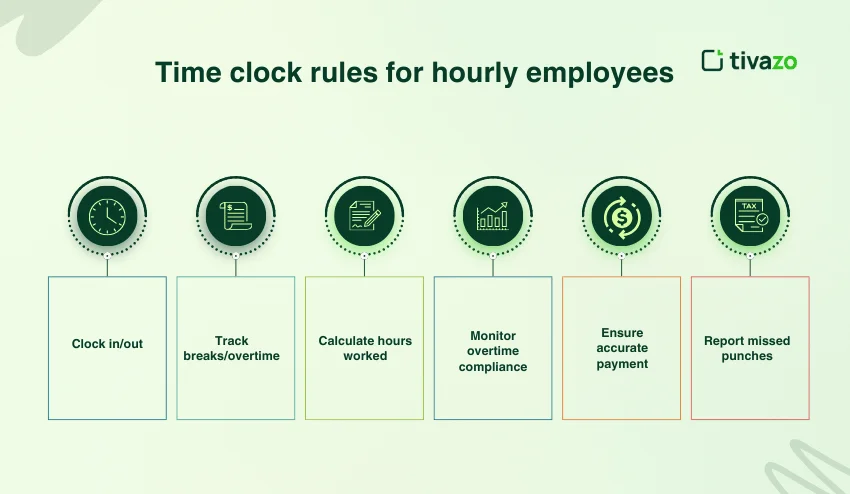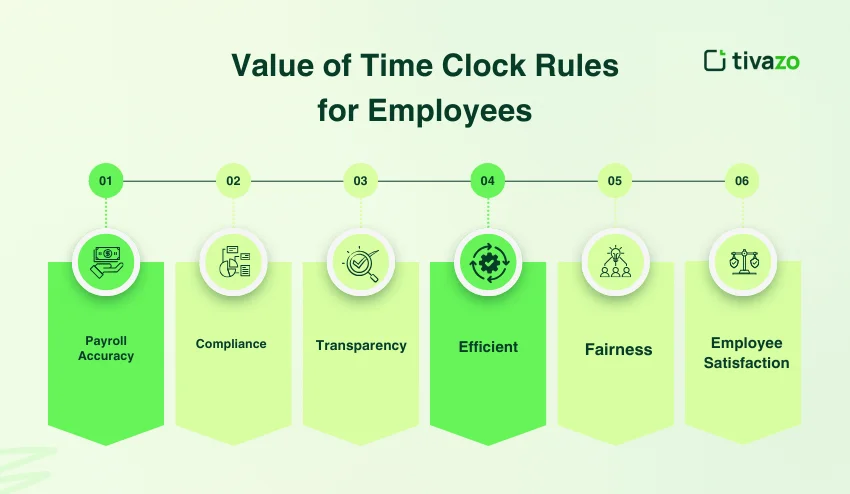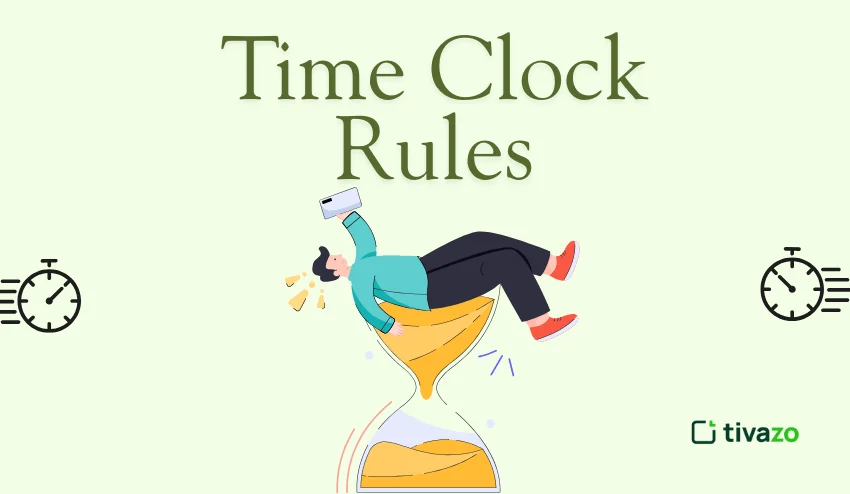In almost every organization, tracking employees’ work hours properly is one of the most pivotal jobs. From fairness in wages to compliance with labor laws, time clock rules for employees provide the infrastructure to keep the maintenance of an organized and safe compliant. In the absence of time clock rules for employees, a business faces the potential of payroll disputes and compliance violations, as well as reduced productivity.
In this guide, we review the most important time clock rules that every business should adhere to, we cover the well-known 7-minute rule, and we cover best practices for hourly and salary employees.
Whether you are an employer writing policies or an employee seeking clarity, knowing time clock rules will help your organization run more efficiently and fairly.
What Is a Time Clock?
A time clock is a device that documents the opposite employee’s start and end times of work. Traditionally, this meant punching a card that recorded into a time clock, but in the present day, most companies utilize a time clock software, application, or biometric time clock to keep a record of hours.
Time clocks are important because they:
- Pay employees accurately.
- Provide compliance with labor laws.
- Help avoid disputes regarding hours worked.
- Easily record overtime and additional hours.
- Monitor employee attendance and punctuality.
- Allow payroll to run simply and quickly, and reduce the chances of administrative mistakes and errors.
- Make available data for reviews of performance and productivity.
- Enable effective management for a remote/hybrid workforce.

What Are the Time Clock Rules for Employees?
Time clock rules for employees are the rules for how employees will record their hours worked by clocking in and out. These rules are important to ensure consistency and fairness to both employers and employees, and legal compliance. Having clear time clock rules also helps eliminate payroll errors, minimize disputes among employees as well and maintain clear records for audits or regulatory issues.
Commonly used time clock rules:
- Employees should clock in or out at the beginning and end of their shifts.
- Break and meal periods must be clocked according to the policies defined.
- Any overtime must be reported accurately and in a timely manner.
- Employees must not clock in for someone else (you may have heard it called “buddy punching”).
- Employers must provide pay for all time worked after an employee is clocked in.
- Employees should report any problems/problems with the time clock system immediately.
- When everyone follows the time clock rules correctly, everyone is treated equally.
Supervisors should perform regular reviews of time clock records in a manner consistent with policies to ensure compliance and accuracy.
When everyone understands the rules for clocking in and out, with the business’s timekeeping rules, it creates transparency and improves trustworthiness in the work environment. Employees understand what the expectation is for hours worked, as well as payroll.
The 7-minute rule for timekeeping
The 7-minute rule, part of the Fair Labor Standards Act (FLSA), allows employers to round up or down the time worked by hourly (non-exempt) employees to the nearest quarter. The purpose of the rule is to simplify payroll calculations and minimize the administrative burden of tracking exact minutes while ensuring employees are paid fairly.
How the 7-minute rule is applied
- If an employee punches in 1–7 minutes early or late, the time is rounded down.
- If an employee punches in 8–14 minutes early or late, the time is rounded up.
| Timecard Entry | Time Assigned |
| 8:07 AM | 8:00 AM |
| 8:08 AM | 8:15 AM |
The 7-minute rule allows employers to facilitate a payroll process, eliminate fights over minute discrepancies, and ensure compliance with state and federal labor laws. It is also beneficial to employees, as it applies a standard process for calculating hours worked and provides fairness.
Rounding must be applied uniformly to all employees; however, if it is not, it can lead to complaints, and in egregious cases, litigation. Many organizations use the 7-minute rule along with modern digital time clocks to automate rounding and minimize errors and payroll processing. Here again, it is important to document the application and communicate the use of the 7-minute rule so that employees can easily understand how their total hours are calculated.
Time clock rules for hourly vs. salary
Hourly employees
- Must clock in and out for each shift.
- Breaks and daily overtime must be tracked.
- Pay is calculated solely on hours worked.
- Employers must properly monitor and track hours of overtime hours to comply with the law.
- When time is kept accurately, hourly employees are paid properly for every single minute they work.
- Employees should be encouraged to notify and correct missed punches or mistakes before payroll to avoid paycheck discrepancies.

Salary employees
- Often not required to clock in/out of shifts, but they may follow time clock rules for reporting attendance.
- Salaried employees must report time for productivity tracking, project hours, and flexible work time reporting.
- Salaried employees are typically not paid overtime unless they are classified as non-exempt employees.
- Having records of time helps employers with staff distribution and project efficiency.
- Even salaried employees will benefit from clear policies to help avoid misunderstandings related to work time.
| Category | Hourly employee | Salary employee |
| Time Tracking | Mandatory clock in/out | Optional, typically clock in/out for attendance |
| Overtime Pay | Yes, over 40 hours | Very rare, unless they are non-exempt |
| Pay Calculation | Per hour worked | Annual/Monthly salary |
Understanding the differences between hourly and salaried employees can help businesses follow time clock rules effectively while promoting fair labor practices and complying with labor laws for all employees. Further, having a clear timekeeping policy will reduce confusion and promote trust in the workplace.
Value of Time Clock Rules for Employees
Having a clear set of time clock rules for employees benefits both employers and employees by providing more structure and transparency around the process of tracking hours worked.
1. Payroll Accuracy
Clearly defined rules eliminate errors in calculating pay or wages, and ensure that employees get paid for every hour worked, including overtime or breaks. It also ensures that payroll is accurate, thereby reducing the chances of payroll disputes or payroll corrections, which are not only time-consuming but a waste of resources for HR teams.
2. Compliance
Compliance with designated time clock rules will enable your business to comply with federal and state labor laws, including the Fair Wage Standards Act (FLSA). The more compliant your business is with labor laws, the less chance you have of receiving fines, lawsuits, or labor audits.
3. Transparency
Clearly communicated time clock rules create transparency and foster trust between employees and management. Employees will know with certainty how hours are being tracked and will know that payroll is computed fairly.
4. Efficient
Automated time clock systems and clearly defined time clock rules will significantly reduce the amount of work conducted by administrative staff, streamline payroll, and eliminate the headaches of manual time clock tracking, which can be subject to so many issues.
5. Fairness
Consistent and standardized time clock rules mean that all employees are treated the same, equally, in the workplace. Staff do not benefit from punching in early, skipping punches, or the inconsistency of human tracking, creating a positive workplace culture.
6. Employee Satisfaction
The acknowledgment of accurately tracked work hours and the knowledge that they are being treated fairly and equitably increases employee satisfaction and decreases tension in the workplace.
In summary, implementing time clock policies and procedures results in a win-win situation: employers save time and lessen mistakes while employees gain clarity and reliability that their work is recognized and compensated appropriately.

Best Practices for Utilizing an Employee Time Clock
Whether you’re taking advantage of time clock rules for employees for the first time or evaluating your existing processes to see if they can be improved, these best practices will help you.
- Stop “buddy punching” by using digital or biometric systems.
- Don’t simply leave the time clock rules a mystery within your employee handbook.
- Provide training to your employees regarding how to clock in/out correctly.
- Conduct audits of the time records to find errors.
- Integrate the time clock system with your payroll software.
- Encourage employees to report any problems with time clocking in/out immediately to avoid payroll problems.
- Find a way to send automatic reminders or notifications for employees who forget to clock in/out.
- Periodic review to analyse time clock data may give you insights regarding lateness or absence patterns.
- Regularly remind your managers to enforce the rules consistently and fairly for all staff.
Having the best practices in place not only avoids payroll problems, but it also improves accountability and trust in the workplace, which is what is needed to make time clock rules effective for everyone involved.
Best Employee Time Clock for Small Business: Focus on Tivazo
If you’re a small business that needs to track employee time without spending too much money, Tivazo is a solid, flexible solution that’s simple to use. Adaptable for remote or on-site teams, Tivazo has all the tools for time tracking and productivity enhancements you need.
Features of Tivazo
- Automated Time Tracking: No need to worry about employees entering their own work hours, as Tivazo automatically tracks when employees work. This saves time and provides more accurate time records for your employees.
- Real Time Monitoring: Managers thrive when they have live access to their team’s clock-ins, work sessions, and idle clocks to help them provide support and proactive problem-solving.
- Robust Reporting: Managers can quickly develop timesheets and reports by day, week, or month, and export them as either a CSV, Excel, or PDF to send for payroll.
- Idle Time Alerts: With Tivazo, you can set thresholds for actions to alert you if they exceed a threshold level of idle time so you can quickly address these sorts of productivity problems as they arise.
- Manual Time Entries: If your staff is out working remotely or is involved in tasks that require activity outside of hours, your employees have the option of manually logging the amount of time they worked. If they are unable to log their time in the moment, they can do it later.
- Cross-Platform: Tivazo can be accessed on Windows, macOS, Linux, Android, iOS, and the web, so you are unlikely to get stuck between devices.
Why Our Small Business Clients Choose Tivazo?
- Affordable: Tivazo has a free plan with unlimited users, has all premium features, and at a time length, all as an affordable option for a small business.
- Intuitive: Our well-planned design means employers and employees are not confused; everyone can find their way around the system with ease.
- Flexible: Tivazo accommodates when your business grows in users or begins to require more complex time tracking.
- Efficiency: By automating time tracking and giving actual visualizations, Tivazo recognizes lost productivity and inefficiencies, ultimately increasing productivity by dealing with the solutions to the problems.
The implementation of Tivazo will not only improve your time management but will also greatly reduce your administrative burden each pay period while giving you accurate payroll. Our entire system is built to provide your small business with features to effectively keep track of your workforce without the trouble and work of paper documents.

Can My Employer Withhold Pay if I Forget to Clock In?
No. Employers are legally required to pay employees for all work time, regardless of whether they forget to clock in or not. Of course, if you habitually forget to clock in, even when there is a time clock policy, then those repeated violations may subject you to disciplinary action.
The best idea is to have a time clock that has automatic reminders or a mobile clock-in option, which would help reduce employee error.
Conclusion
Establishing correct time clock rules for your employees is critical for payroll accuracy, compliance with laws, and fairness in your workplace. An organization that accepts a few basic time clock rules goes a long way toward avoiding disputes and establishing trust in its teams. There are fairly simple guidelines when it comes to the “7-minute rule” and the distinctions between hourly and salaried employees.
From either a small business owner’s perspective or being a part of a company, implementing the appropriate employee time clock system and creating effective employee time clock policies will save your organization time, money, and angst down the road.




